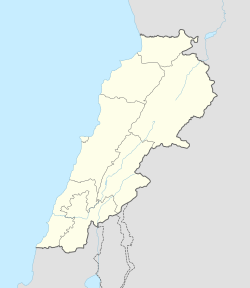Bane, Lebanon
|
Bann بان |
|
|---|---|
| City | |

The village of Bane seen from Ehden, July 2004
|
|
| Location within Lebanon | |
| Coordinates: 34°16′41″N 35°57′18″E / 34.27806°N 35.95500°ECoordinates: 34°16′41″N 35°57′18″E / 34.27806°N 35.95500°E | |
| Country |
|
| Governorate | North Governorate |
| District | Bsharri District |
| Elevation | 1,420 m (4,660 ft) |
| Time zone | EET (UTC+2) |
| • Summer (DST) | EEST (UTC+3) |
| Dialing code | +961 |
Bane (Bann)(Arabic: بان) is a Christian village located in the North Governorate of Lebanon. The inhabitants are Maronite Christians.
It is situated in north of Lebanon as a very holy and spiritually dearly held location – The Valley of Qadisha also known as The Valley Of The Saints.
There are approximately 15,000 Bane Christian descendants living in Australia, Brazil and USA These descendants have prospered in the areas of construction, property development and many other businesses. Bane people have contributed immensely to both Australian and Lebanese causes, charities and heritage. Bane is situated at an altitude of 1,470 metres and is 132 km from Beirut; 46 km from Tripoli and 8 km from the Cedars. Bane, is located on the road going from Ehden to Bsharri in the northern part of the Qadisha valley, Bane is mentioned in documents as old as 1265 AD.
Originally, there were only a handful of families that originated from Bane however over time, many families have branched out from several of the larger families which now form over 40 last names or migrated from other villages many years ago. Below is a complete list of all families from Bane today.
Abraham, Antoun, Aouchan, Aoutel, Abdo, Abdow, Bainy, Baynie, Beaini, Bainey, Chamis, Chiha (Sheehi in North America), Daaboul, Daboul, Daoud, Elhage, Estephan, Fachkha, Fahim, Gabriel, Habkouk, Hajje, Halabi, Hassarati, Kawtel, Khamis, Khedair, Khodeir, Khoudair, Khoury, Lahoud, Maait, Mahboub, Massoud, Merhi, Miate, Mait, Mikhael, Moit, Mouhayet, Moussa, Nadwie, Nasr, Saliba, Saymon, Semaan, Srour, Sukari, Solomon, Tadros, Zaiter, Zeaiter, Ziedan.
The priest Daniel from the Village of Bane had written a manuscript in the time of Patriarch Dawud (David) surnamed Yuhanna (John) residing at the Mar Sarkis monastery in the land of Hardin c.1397 AD.
The monk Youhanna Ben Namroun El-Banny was the Superior of Saint Antonious Qozhaya Monastery in the year 1529. He was re-elected superior of the Monastery in 1556,
Brother of Murhej Nairoon El-Banny. He entered the Maronite college in 1642, and was ordained a priest in 1663 at Ravenna, Italy.
His father was from Bane, but Murhej was born in Rome around 1625. His Lebanese name 'Murhe' was translated into Latin as 'Faustus' he entered the Maronite College in Rome in 1636 and completed his studies in 1649 and returned to Lebanon. In 1650, he was ordained priest at Mar Abda Heraraya by Patriarch Yuhanna Safrawy. He was sent in the same year to Rome by the Patriarch to oversee the printing of the Phenqitho, the Maronite "proper of the Saints" in Syriac. In Rome, in order to obtain the permission to print this book Faustus was requested, to translate it into Latin and submit the translation to a Roman committee for examination. Abraham Echellensis, maternal uncle of Faustus (Murhej), was one of the five members of this committee. This book was printed in Rome in 1666 by the congregation of Propaganda Fide.
...
Wikipedia

